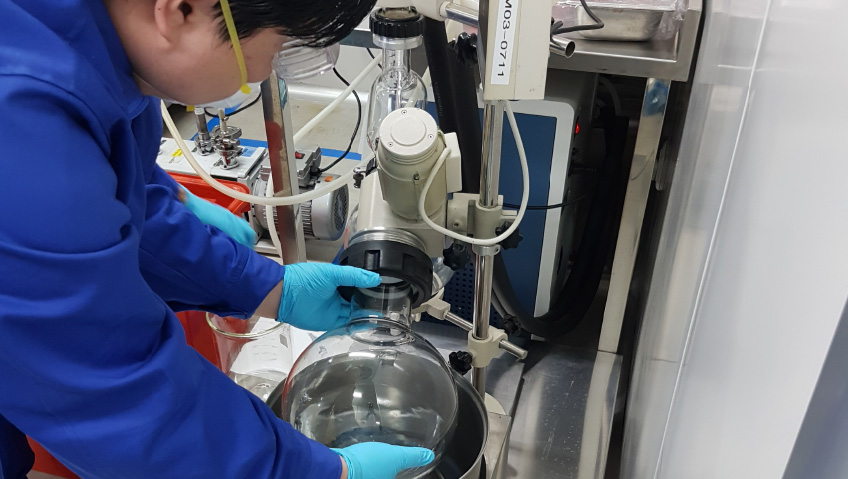When physical pain occurs—whether from an injury, surgery, or the ravages of cancer—finding the right product to alleviate symptoms can be a matter of trial and error, and is often fraught with side effects including addiction and overdose. WEX Pharmaceuticals Inc., a late-stage drug development company based in Vancouver, BC, is dedicated to reducing those threats through research, development, and manufacture of Halneuron®, a new non-opioid analgesic considered to be a breakthrough in pain-management technology.
Halneuron—currently in Phase III clinical trials for neuropathic pain brought on by chemotherapy—is also being studied for additional pain indications, with more than 700 patients having been previously treated by the drug.
Tetrodotoxin (TTX), Halneuron’s active ingredient, is a sodium channel blocker that prevents pain signals from reaching the brain without the negative effects of opioids, the current gold standard for treating moderate to severe pain.
While opioids have substantial drawbacks and hazards when used long-term, including adverse effects on the respiratory, gastrointestinal, and central nervous systems, and putting patients at risk for addiction and tolerance, Halneuron promises to revolutionize how the brain perceives both short- and long-term pain.
A subsidiary of CK Life Sciences Int’l., (Holdings) Inc., a publicly traded company in Hong Kong, WEX is headed by CEO Walter Korz, who has a distinguished background in the healthcare industry, including experience with concerns such as rheumatoid arthritis, cancer, multiple sclerosis, and now pain management.
“I’m also pleased to say we have a strong management team,” says Korz of the focused group of nine people who understand the core of the business and drive its research, manufacturing, and business development.
“We stay lean by relying on a strong network of competent contractors from animal studies to manufacturing, spending a high percentage of our money on the actual drug development rather than on overhead,” he explains.
WEX is also a long-time member of Life Sciences BC, a non-profit, non-governmental organization, and an important element of the healthcare biosphere, providing networking events and continuing education, and serving as a conduit to government services and other pharmaceutical companies and agencies.
“They’re the glue that keeps this sector here in BC attached and a vibrant community,” says Korz.
While numerous factors set WEX apart from others in the pain management field, it’s the company’s unique technology that has truly made it stand out, says Korz. “We’re succeeding where others have failed.”
Pain is a “very subjective” area of research, he explains, compared with cancer, for instance, where a CT scan can measure the size of a tumour and, after a drug is administered, doctors can accurately establish whether the tumour has shrunk. “That’s a very good surrogate marker of efficacy, and you measure how long somebody lives without their disease coming back,” he says.
With pain, he says, it’s more nebulous. You’re taking something that’s not quantifiable, that’s subjective, and you’re trying to quantify it.
“We try to take something subjective and turn it into objective data,” Korz says. “You use pain scales and try to have patients answer questionnaires about how their pain is progressing, and then you try to see whether your drug is doing something compared to a placebo.”
Placebo effects are real, he adds, and response can be as high as 30 to 40 percent. Sometimes when doctors or nurses ask patients to assess their pain score on a scale, patients tend to say “better” so as not to disappoint their doctors.
“It’s hard to prove [the efficacy of] a drug when you get 30 percent of the people on placebo saying they’re better,” Korz says. “So that’s one of the challenges we have.”
WEX employs technology to capture patients’ data more effectively—for example, using cell phones to more accurately record pain scores in real time. “But it comes down to our technology with our drug itself and how it’s working,” he says. “The pain drugs we’re routinely using today are no different than 30 years ago. There are different ways of delivering it; you can put fentanyl in a lollipop and give that to a patient, as an example, but essentially, they’re the same kind of drugs.”
WEX’s Halneuron, however, is a non-opioid drug designed to address moderate to severe pain indications with no evidence of addiction or withdrawal symptoms and doesn’t cross the blood-brain barrier, a vital distinction.
“Many of these drugs being used today are absorbed into the brain where they relieve the pain,” says Korz. “But at the same time, you may experience side effects such as confusion, somnolence, respiratory depression, euphoria. And before you know it, evidence tells us some patients are abusing these drugs.”
A worldwide opioid crisis points to the undeniable fact that new ways of treating pain are desperately needed. Halneuron, administered through an injection twice a day for four days, has resulted in some patients reporting pain relief, not for hours or days, but for weeks and months, a truly remarkable effect.
“Despite everything the government is doing, deaths from drug use are increasing, not decreasing,” says Korz. There has been a 26 percent increase in the number of drug deaths since 2020, despite more treatments and detox facilities, better control of prescription drugs, and limiting the types and number of doses per patient.
“The sad truth is those people that are on the street didn’t decide one day to get up in the morning and become addicted to an opioid. In fact, 70 percent of people who abuse these drugs started from a doctor’s prescription—an athlete who got injured, or a routine surgery that ended up needing analgesics. There are many, many reasons that everybody in their life will at some point need an analgesic.”
While media reports are rife with celebrity addictions and overdoses, Korz stresses it’s mainly everyday, ordinary people who are suffering.
“We’re trying to provide a tool for physicians that is safe, efficacious, and gives them some additional drugs they can use, and introduce something novel,” he says. “This is a drug that interrupts the pain signal from the periphery, meaning from your external to your central nervous system, and prevents the pain signal from reaching the brain. If it does that, then there’s no perception of pain.”
WEX has conducted 15 clinical trials to date and has administered the drug to late-stage cancer patients and healthy volunteers at the same dose, showing a patient can take a dose of the drug and go back to work without feeling sleepy or confused. “We’ve shown we can reduce pain even in some of those patients that had intractable pain and were not responding anymore to opioids or couldn’t tolerate them. There was a statistically significant reduction of pain in this patient group,” Korz says. “That’s compelling evidence.”
WEX has also demonstrated that, when introducing its drug, the amount of opioids used decreases. “Our drug is safe, and our clinical evidence to date supports that,” he says. “We’re changing the way the brain is perceiving long-term chronic pain.”
WEX is also looking at chemo-induced neuropathic pain, a peripheral neuropathy caused by chemotherapy damaging the nerves, sometimes permanently. When this occurs, chemo is usually stopped, as there is currently no drug that can treat the condition, including opioids. WEX is investigating methods of treating this and has been developing and conducting clinical trials, recently launching a Phase Two trial in Korea, Taiwan, the U.S., and Canada.
“The difference between our company and others who have tried and failed, again, comes down to the way our drug works,” says Korz. “Nature produces drugs for us. This is part of pharmacy called pharmacognosy, taking active ingredients from plants and animals, refining them, and making them into pharmaceutical drugs that are useful to humans.”
This group of drugs includes penicillin from mould, heroin from poppy plants, insulin from the pancreas of a pig, and Taxol, from the bark of yew trees, one of the most successful chemotherapeutic agents. In fact, 70 percent of drugs used today had their genesis in plant or animal chemistry, says Korz. Tetrodotoxin is also extracted from nature: a toxin found in puffer fish used as a defence against predators.
“It’s a complicated molecule. It’s a gift from nature in that it’s very efficient in blocking a channel critical for the sensation of pain. People have tried to emulate that molecule from chemistry and haven’t been successful,” Korz says. “Our success is that this chemical that nature has produced is very efficient at targeting sodium channels. We use this chemical, refine it, purify it, and make it into a drug.”
While tetrodotoxin is a toxin, WEX has shown it can be used and handled safely and is far less dangerous than many analgesics being used today, but that process hasn’t been easy, with the company overcoming “hurdle after hurdle” to prove its safety.
“We’re faced with this challenge all the time,” Korz says. “We have a potent drug, and it becomes a question of educating even the companies that normally manufacture drugs. We need to work with them closely to convince them of the safety profile of our drug for their workers.”
Due to this, the number of manufacturers that will work with WEX is limited, he adds. Of course, it’s not just a matter of educating manufacturers, but also preclinical and regulators about the use and safety profile of the drug.
Despite all the challenges faced, from production to manufacturing, trials, and ongoing education, WEX remains dedicated to its goal of helping people fight pain in new and safer ways.
“Everybody at one point in their life will need to take some sort of painkiller,” Korz says. “Not everybody’s going to be touched by cancer or heart disease or some other [severe] affliction, but everybody will experience pain of some sort that needs help,” he says.
“There’s a ‘heart’ factor in the people involved in this development,” Korz says. “This isn’t just a job to them; they’re committed to seeing this being put in the hands of doctors to alleviate pain and suffering in the people that really need it.”






